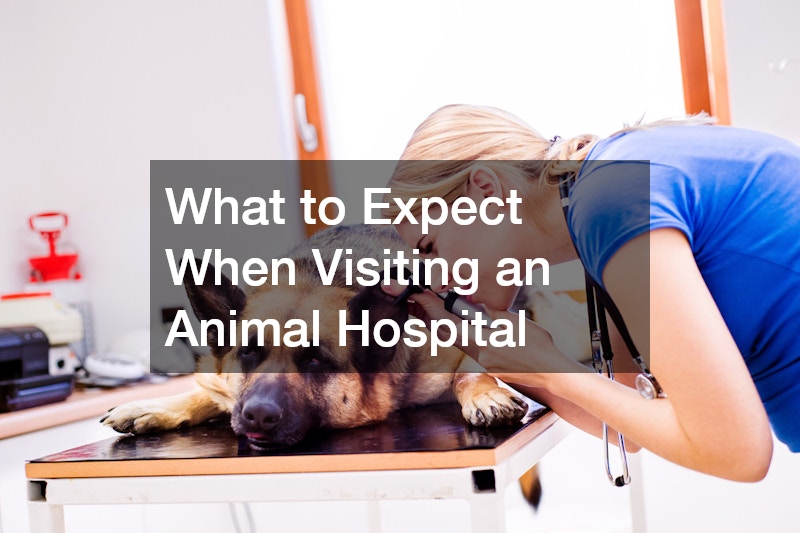Visiting an animal hospital can be a daunting experience for pet owners, especially if it’s your first time. The unfamiliar environment, the concern for your pet’s health, and the uncertainty about what will happen can all add to your anxiety. However, understanding what to expect during the visit can significantly ease your worries and help you feel more confident throughout the process.
Knowing how the check-in procedure works, what the initial assessment involves and the types of treatments that may be recommended allows you to prepare yourself and your pet better. Additionally, being aware of follow-up care and how the veterinary team supports recovery can provide reassurance that your pet is in good hands. This guide outlines the typical journey from arrival to discharge and offers practical advice on what you need to bring and how to best support your pet during their visit.
Arrival & Check-In Process
When you first arrive at the facility, you will usually be greeted by a receptionist who will ask for details about your pet and the reason for your visit. It’s helpful to bring along any medical records, vaccination history and notes on your pet’s behaviour or symptoms. This information allows the veterinary team to get a clearer picture of your pet’s health and any underlying issues.
Most veterinary centres keep records digitally, so providing up-to-date contact details ensures smooth communication during your pet’s treatment. If it’s an emergency visit, you may be asked to fill out forms quickly before your pet is seen by the vet.
Initial Assessment & Consultation
Once checked in, your pet will be taken to an examination room where the veterinarian or vet nurse will perform an initial assessment. This typically involves checking your pet’s vital signs such as temperature, heart rate and respiration. The vet will then discuss your concerns and ask specific questions about your pet’s symptoms or behaviour.
This is a great time to be open and detailed about what you’ve observed. Even small changes can be important in diagnosing your pet’s condition. The vet may also ask about your pet’s diet, exercise and any previous illnesses or treatments.
Diagnostic Tests & Treatment Plan
Depending on the initial assessment, the vet may recommend diagnostic tests such as blood work, X-rays or ultrasound scans. These tests help confirm a diagnosis and guide the best course of treatment. The hospital will have specialised equipment and trained staff to perform these procedures safely and efficiently.
Once the diagnosis is clear, the veterinarian will explain the treatment options available. This may include medication, surgery or other therapies tailored to your pet’s needs. It’s important to ask questions if you’re unsure about any part of the treatment plan. Understanding the benefits, risks and expected outcomes helps you make informed decisions for your pet’s care.
Hospitalisation & Monitoring
In some cases, your pet may need to stay overnight for monitoring or treatment. This is common for surgeries, severe illnesses or after an emergency procedure. The staff will provide round-the-clock care, including administering medication, feeding and checking vital signs.
Many facilities use modern wards designed to keep pets comfortable during their stay. You might be able to visit your pet or receive regular updates on their progress. Knowing that your pet is in expert hands can be reassuring during this time.
Discharge & Aftercare Instructions
When your pet is ready to go home, the vet or nurse will give you detailed instructions on aftercare. This includes information on medication schedules, wound care, diet, exercise restrictions and any signs of complications to watch for. Following these instructions closely is essential for a smooth recovery.
The animal hospital may also schedule follow-up visits to monitor your pet’s progress and adjust treatment if necessary. Don’t hesitate to contact the team if you have any questions or concerns after leaving.
Tips for a Smooth Visit
To make your visit as stress-free as possible, it’s important to arrive on time or a few minutes early to allow enough time to complete any necessary paperwork. Bringing a familiar blanket or toy can help comfort your pet and reduce anxiety during the visit. Keeping your pet calm and properly restrained is also essential for their safety and the safety of the staff. It’s a good idea to prepare any questions or concerns you may have beforehand so you can discuss them clearly with the vet. Lastly, make sure to follow the centre’s guidelines for both emergency and non-urgent visits to ensure a smooth experience for everyone involved.
Visiting an animal hospital is a crucial part of responsible pet ownership. Understanding the process from arrival to discharge helps you feel confident and prepared. The veterinary team is dedicated to providing compassionate and expert care, ensuring your pet’s health and wellbeing come first. By following this guide, you can help make the experience positive for both you and your pet.
.







